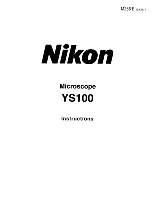
18
Fig. 24
Fig. 25
Fig. 26
5-3 Stage
1
Placing the Specimen
} The dimensions of the slide glass should be 26 x 76 mm with thickness of
0.9 to 1.2 mm, and the cover glass should have thickness of 0.17 mm.
} When observing very large specimens, remove the slide holder and place
the specimen directly on the stage.
Microscopy with Double-Slide Holder (Fig. 24)
1. Turn the coarse adjustment knob @ to lower the stage.
2. Open the spring-loaded curved finger
2
on the slide holder and place
one or two specimen slides on the stage from the front.
3. After placing the sides as far as they will go, gently release the curved
finger.
Microscopy with Single-Slide Holder (Fig. 25)
The specimen side can easily be placed by sliding it into the slide holder
from the front.
Examining a whole specimen
Use one of the thin slide holders listed below that cause less interference
with the objectives
*
.
· U-HRD-4 · U-HLD-4 · U-HLS-4
*
The applicable objectives are ones with 40X or less magnification (except
Apo series).
Using an Oil Immersion Condenser
Use the optional U-SVRO (right-hand knob) or USVLO (left-hand knob)
slotted stage which prevents close contact between the specimen and
stage.
2
Using the Auxiliary Slide Holder
} When a biological slide glass specimen is placed on the U-HLDT4/U-
HRDT4 two-slide holder (thick type), the slide holder may interfere with
the objective when the following conditions are combined;
· The objective in use has a short WD (Working Distance);
· The sspecimen being observed is the specimen placed on the rear
side of the side holder, and;
· The stage is in a rotated position.
If the slide holder contacts the objective, set the provided auxiliary slide
holder @ as shown in the figure and observe only the specimen on the
front side of the slide holder.
Applicable revolving nosepieces: U-D7RE, U-D7RES, U-P6RE,
U-D6BDRE, U-P5BDRE
1
1
2
















































